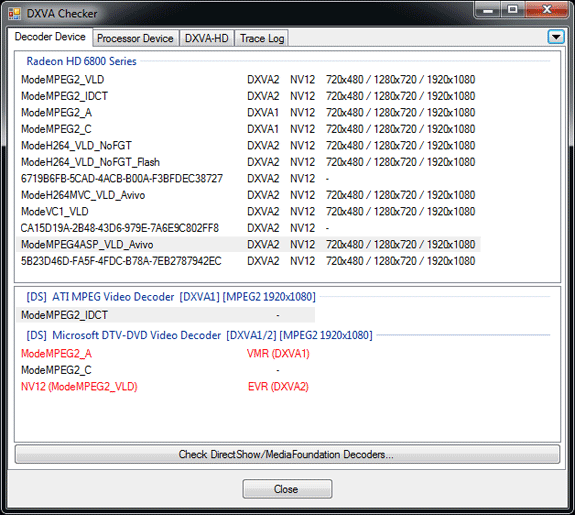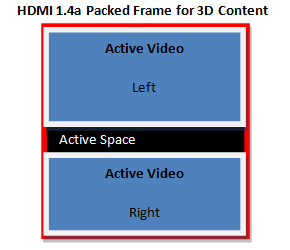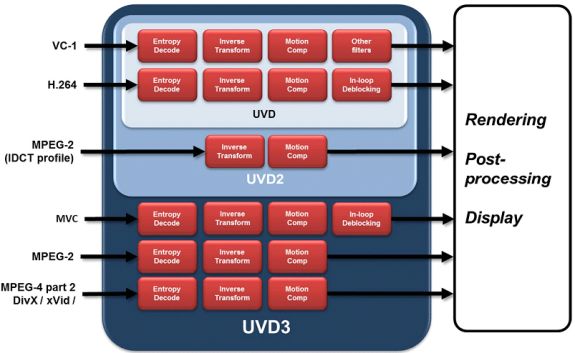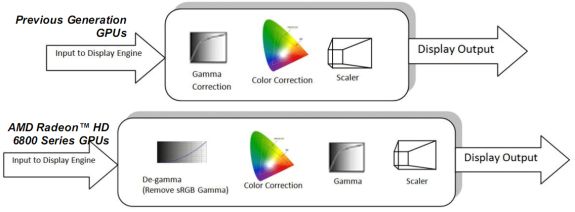AMD’s Radeon HD 6870 & 6850: Renewing Competition in the Mid-Range Market
by Ryan Smith on October 21, 2010 10:08 PM ESTSeeing the Present: HDMI 1.4a, UVD3, and Display Correction
DisplayPort wasn’t the only aspect of AMD’s display controller that got an overhaul however, AMD’s HDMI capabilities have also been brought up to modern standards. Coming from Cypress with support for HDMI 1.3, AMD now supports HDMI 1.4a on the Barts based 6800 series and presumably they will do so on the rest of the 6800 series too. With HDMI 1.4a support AMD can now support full resolution (1080p) 3D stereoscopy for movies, and 720p for games and other material that require 60Hz/eye, along with 4k x 2k resolution for monitors and TVs that have equivalent support. Unlike DP this has less to do with monitors and more to do with TVs, so the importance of this will be seen more on future AMD cards when AMD refreshes their lower-end parts that we normally use with HTPCs.
Launching alongside support for displaying full resolution 3D stereoscopic video is the hardware necessary to decode such video, in the form of the latest version of AMD’s Unified Video Decoder: UVD3. The last time UVD received a major update was with UVD2, which launched alongside the Radeon HD 4000 series and added partial MPEG-2 decoding support by moving IDCT and MoComp from shaders in to the UVD fixed function hardware.
With the Radeon 6800 series AMD is releasing UVD3, which like UVD2 before it builds on the existing UVD feature set. UVD3 is adding support for 3 more-or-less new codecs: MPEG-2, MVC, and MPEG-4 ASP (better known as DivX/XviD). Starting with MPEG-4 ASP, it’s the only new codec in supported by UVD3 that’s actually new, as previously all MPEG-4 ASP decoding was done in software when it came to AMD GPUs. With UVD3 AMD can now completely offload MPEG-4 ASP decoding to the GPU, bringing forth the usual advantages of greatly reducing the amount of work the CPU needs to do and ideally reducing power consumption in the process.
AMD adding MPEG-4 ASP support gives us an interesting chance to compare and contrast them to NVIDIA, who added similar support a year ago in the GT21x GPUs. AMD is a good bit behind NVIDIA here, but they’re making up for it by launching with much better software support for this feature than NVIDIA did; NVIDIA still does not expose their MPEG-4 ASP decoder in most situations, and overall did a poor job of advertising it. When we talked with DivX (who is AMD’s launch partner for this feature) they didn’t even know that NVIDIA had MPEG-4 ASP support. Meanwhile AMD is launching with DivX and had a beta version of the DivX codec with UVD3 support ready to test, and furthermore AMD is fully exposing their MPEG-4 ASP capabilities in their drivers as we see in this DXVA Checker screenshot.

The only downside at this time is that even with Microsoft’s greater focus on codecs for Windows 7, Windows 7 doesn’t know what to do with DXVA acceleration of MPEG-4 ASP. So while Win7 can play MPEG-4 ASP in software, you’re still going to need a 3rd party codec like the DivX codec to get hardware support for MPEG-4 ASP.
The other bit worth mentioning is that while AMD is launching support for MPEG-4 ASP decoding here on the 6800 series, much like HDMI 1.4a it’s not going to be a big deal for the 6800 series market. MPEG-4 ASP is a fairly lightweight codec, so support for it is going to be a bigger deal on low-end products, particularly AMD’s APUs if Llano and Bobcat end up using UVD3, as MPEG-4 ASP decoding in software requires a much greater share of resources on those products.
Up next is MPEG-2, which has been a codec stuck in limbo for quite some time over at AMD. MPEG-2 is even older and easier to decode than MPEG-4 ASP, and while GPUs have supported MPEG-2 decode acceleration as early as last decade, CPUs quickly became fast enough that when combined with low levels of hardware decode acceleration (inverse discrete cosine transform) was more than enough to play MPEG-2 content. Thus AMD hasn’t done much with MPEG-2 over the years other than moving IDCT/MoComp from the shaders to UVD for UVD2.
Because of the similarities between MPEG-4 ASP and MPEG-2, when AMD added support for full MPEG-4 ASP decode acceleration they were able to easily add support for full MPEG-2 decode acceleration, as they were able to reuse the MPEG-4 ASP entropy decode block for MPEG-2. As a result of including full MPEG-4 ASP decode acceleration, AMD now supports full MPEG-2 decode acceleration. Even more so than MPEG-4 ASP however, the benefits for this are going to lie with AMD’s low-end products where getting MPEG-2 off of the CPU should be a boon for battery life.

The final addition to UVD3 is support for Multiview Video Coding, which isn’t a new codec per se, but rather is an extension to H.264 for 3D stereoscopy. H.264 needed to be amended to support the packed frame formats used to store and transmit 3D stereoscopic videos, so with UVD3 AMD is adding support for MVC so that UVD can handle Blu-Ray 3D.
Finally, coupled with support for new codecs and new display outputs in AMD’s display controller is a refinement of AMD’s existing color correction capabilities in their display controller. Cypress and the rest of the 5000 series could do color correction directly on their display controllers, but they could only do so after gamma correction was applied, meaning they had to work in the non-linear gamma color space. Technically speaking this worked, but color accuracy suffered as a result. With the 6800 series’ new display controller, AMD can now perform color calibration in linear space by converting the image from gamma to linear color space for the color correction, before converting it back to gamma color space for display purposes.
As color correction is being used to correct for wide-gamut monitors the importance of this change won’t be seen right away for most users, but as wide-gamut monitors become more widespread color correction becomes increasingly important since wide-gamut monitors will misinterpret the normal sRGB colorspace that most rendering is done in.












197 Comments
View All Comments
Quidam67 - Friday, October 29, 2010 - link
Well that's odd.After reading about the EVGA FTW, and its mind-boggling factory overclock, I went looking to see if I could pick one of these up in New Zealand.
Seems you can, or maybe not. As per this example http://www.trademe.co.nz/Browse/Listing.aspx?id=32... the clocks are 763Mhz and 3.8 on the memory?!?
What gives, how can EVGA give the same name to a card and then have different specifications on it? So good thing I checked the fine-print or else I would have been bumbed out if I'd bought it and then realised it wasn't clocked like I thought it would be..
Murolith - Friday, October 29, 2010 - link
So..how about that update in the review checking out the quality/speed of MLAA?CptChris - Sunday, October 31, 2010 - link
As the cards were compared to the OC nVidia card I would be interested in seeing how the 6800 series also compares to a card like the Sapphire HD5850 2GB Toxic Edition. I know it is literally twice the price as the HD6850 but would it be enough of a performance margin to be worth the price difference?gochichi - Thursday, November 4, 2010 - link
You know, maybe I hang in the wrong circles but I by far keep up to date on GPUs more than anyone I know. Not only that, but I am eager to update my stuff if it's reasonable. I want it to be reasonable so badly because I simply love computer hardware (more than games per say, or as much as the games... it's about hardware for me in and of itself).Not getting to my point fast enough. I purchased a Radeon 3870 at Best Buy (Best Buy had an oddly good deal on these at the time, Best Buy doesn't tend to keep competitive prices on video cards at all for some reason). 10 days later (so I returned my 3870 at the store) I purchased a 4850, and wow, what a difference it made. The thing of it is, the 3870 played COD 4 like a champ, the 4850 was ridiculously better but I was already satisfied.
In any case, the naming... the 3870 was no more than $200.00 I think it was $150.00. And it played COD4 on 24" 1900x1200 monitor with a few settings not maxed out, and played it so well. The 4850 allowed me to max out my settings. Crysis sucked, crysis still sucks and crysis is still a playable benchmark. Not to say I don't look at it as a benchmark. The 4850 on the week of its release was $199.99 at Best Buy.
Then gosh oh golly there was the 4870 and the 4890, which simply took up too much power... I am simply unwilling to buy a card that uses more than one extra 6-pin connector just so I can go out of my way to find something that runs better. So far, my 4850 has left me wanting more in GTA IV, (notice again how it comes down to hardware having to overcome bad programming, the 4850 is fast enough for 1080p but it's not a very well ported game so I have to defer to better hardware). You can stop counting the ways my 4850 has left me wanting more at 1900 x 1200. I suppose maxing out Starcraft II would be nice also.
Well, then came out the 5850, finally a card that would eclipse my 4850... but oh wait, though the moniker was the same (3850 = so awesome, so affordable, the 4850 = so awesome, so affordable, the 5850 = two 6-pin connectors, so expensive, so high end) it was completely out of line with what I had come to expect. The 4850 stood without a successor. Remember here that I was going from 3870 to 4850, same price range, way better performance. Then came the 5770, and it was marginally faster but just not enough change to merit a frivolous upgrade.
Now, my "need" to upgrade is as frivolous as ever, but finally, a return to sanity with the *850 moniker standing for fast, and midrange. I am a *850 kind of guy through and through, I don't want crazy power consumption, I don't want to be able to buy a whole, really good computer for the price of just a video card.
So, anyhow, that's my long story basically... that the strange and utterly upsetting name was the 5850, the 6850 is actually right in line with what the naming should have always staid as. I wouldn't know why the heck AMD tossed a curve ball for me via the 5850, but I will tell you that it's been a really long time coming to get a true successor in the $200 and under range.
You know, around the time of the 9800GT and the 4850, you actually heard people talk about buying video cards while out with friends. The games don't demand much more than that... so $500 cards that double their performance is just silly silly stuff and people would rather buy an awesome phone, an iPad, etc. etc. etc.
So anyhow, enough of my rambling, I reckon I'll be silly and get the true successor to my 4850... though I am assured that my Q6600 isn't up to par for Starcraft II... oh well.
rag2214 - Sunday, November 7, 2010 - link
The 6800 series my not beat the 5870 yet but it is the start of the HDMI 1.4 for 3dHD not available in any other ATI graphics cards.Philip46 - Monday, November 15, 2010 - link
The review stated why was there a reson to buy a 460(not OC'ed).How about benchmarks of games using Physx?
For instance Mafia 2 hits 32fps @ 1080p(I7-930 cpu) when using Physx on high, while the 5870 manages only 16.5fps, while i tested both cards.
How about a GTA:IV benchmark?, because the Zotac 2GB GTX 460, runs the game more smoothly(the same avg fps, except the min fps on the 5850 are lower in the daytime) then the 5850 (2GB).
How about even a Far Cry 2 benchmark?
Co'me on anandtech!, lets get some real benchmarks that cover all aspects of gaming features.
How about adding in driver stability? Ect..
And before anyone calls me biased, i had both the Zotac GTX 460 and Saffire 5850 2GB a couple weeks back, and overall i went with the Zotac 460, and i play Crysis/Stalker/GTA IV/Mafia 2/Far Cry 2..ect @ 1080p, and the 460 just played them all more stable..even if Crysis/Stalker were some 10% faster on the 5850.
BTW: Bad move by anandtech to include the 460 FTC !
animekenji - Saturday, December 25, 2010 - link
Barts is the replacement for Juniper, NOT Cypress. Cayman is the replacement for Cypress. If you're going to do a comparison to the previous generation, then at least compare it to the right card. HD6850 replaces HD5750. HD6870 replaces HD5770. HD6970 replaces HD5870. You're giving people the false impression that AMD knocked performance down with the new cards instead of up when HD6800 vastly outperforms HD5700 and HD6900 vastly outperforms HD5800. Stop drinking the green kool-aid, Anandtech.